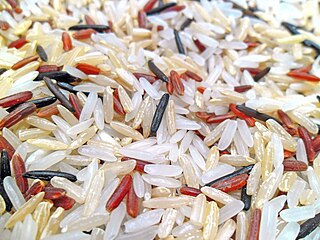
The almond is a species of small tree from the genus Prunus, cultivated worldwide for its seed, a culinary nut. Along with the peach, it is classified in the subgenus Amygdalus, distinguished from the other subgenera by corrugations on the shell (endocarp) surrounding the seed.

The economy of Afghanistan is listed as the 124th largest in the world in terms of nominal gross domestic product (GDP), and 102nd largest in the world in terms of purchasing power parity (PPP). With a population of around 41 million people, Afghanistan's GDP (nominal) stands at $14.58 billion as of 2021, amounting to a GDP per capita of $363.7. Its annual exports exceed $2 billion, with agricultural, mineral and textile products accounting for 94% of total exports. The nation's total external debt is $1.4 billion as of 2022.

Transport in Afghanistan is done mostly by road, rail and air. Much of the nation's road network was built in the mid-20th century but left to ruin during the last two decades of that century due to war and political turmoil. Officials of the current Islamic Emirate have continued to improve the national highways, roads, and bridges. In 2008, there were about 700,000 vehicles registered in Kabul. At least 1,314 traffic collisions were reported in 2022.

Rice is the seed of the grass species Oryza sativa or, less commonly, O. glaberrima. The name wild rice is usually used for species of the genera Zizania and Porteresia, both wild and domesticated, although the term may also be used for primitive or uncultivated varieties of Oryza.

Qunduz is one of the 34 provinces of Afghanistan, located in the northern part of the country next to Tajikistan. The population of the province is around 1,136,677, which is mostly a tribal society; it is one of Afghanistan's most ethnically diverse provinces with many different ethnicities in large numbers living there. The city of Kunduz serves as the capital of the province. It borders the provinces of Takhar, Baghlan, Samangan and Balkh, as well as the Khatlon Region of Tajikistan. The Kunduz Airport is located next to the provincial capital.

Samangan is one of the thirty-four provinces of Afghanistan, located north of the Hindu Kush mountains in the central part of the country. The province covers 11,218 square kilometres (4,331 sq mi) and is surrounded by Sar-e Pol Province in the west, Balkh in the north, Baghlan in the east, and Bamyan in the south.

Daykundi, also spelled as Daikundi, Daikondi, or Daykondi, is one of the thirty-four provinces of Afghanistan, located in the central part of the country. It has a population of about 516,504 and is a Hazara dominated province.
ACDI/VOCA is an international development nonprofit organization based in Washington, D.C., United States, that fosters broad-based economic growth, increased living standards, and community development. Incorporated in 1965, ACDI/VOCA's mission is to promote economic opportunities for cooperatives, enterprises and communities through the innovative application of sound business practice. ACDI/VOCA has worked in 148 countries since 1963. Total revenues for ACDI/VOCA and its affiliates are approximately $154 million. ACDI/VOCA employs approximately 1,270 people in the US and overseas.

Sher Khan or Shir Khan is a border town in the northern Kunduz Province of Afghanistan, next to the Panj River. The town's main attraction is the Sher Khan Bandar, which is a dry port and border checkpoint that officially connects by road Afghanistan with neighboring Tajikistan. It is located about 8 km (5.0 mi) northwest from the center of the town. The city of Kunduz is about 60 km (37 mi) of driving distance south from Sher Khan Bandar. The historical name of the town was Qizil Qalah. It was given the current name in honor of Sher Khan Nashir, Khan of the Nashers. The town has around 600 families.

Agriculture in Ghana consists of a variety of agricultural products and is an established economic sector, providing employment on a formal and informal basis. It is represented by the Ministry of Food and Agriculture. Ghana produces a variety of crops in various climatic zones which range from dry savanna to wet forest which run in east–west bands across Ghana. Agricultural crops, including yams, grains, cocoa, oil palms, kola nuts, and timber, form the base of agriculture in Ghana's economy. In 2013 agriculture employed 53.6% of the total labor force in Ghana.

Mohammed Daud Daud, also known as General Daud Daud, an ethnic Tajik, was the police chief in northern Afghanistan and the commander of the 303 Pamir Corps. He was an opponent of the Afghan Taliban.
Abdul Wahidi or Abdul Bedi is a variety of almonds, grown mainly in Afghanistan. The river valleys of the Khulm River in northern Afghanistan, particularly Balkh province, Samangan province and Kunduz province grow Abdul Wahidi almonds in abundance. Balkh province is said to grow the finest Abdul Wahidi almonds in the world. The Haji Moh area is a known centre of productivity by the Abdul Wahidi firm. Abdul Wahidi nuts are characteristically yellow in color.

Pomegranate production in Afghanistan is a significant contributor to the country's agricultural economy. It likely existed in the country since ancient time. Pomegranates are a major fruit crop in many provinces, particularly in Kandahar, Helmand, Wardak, Ghazni, Paktia, Farah, Kapisa and Balkh, and are the source of the livelihoods of thousands of people.

Coffee production in Jamaica began after 1728, when governor Sir Nicholas Lawes introduced the crop near Castleton, north of Kingston. Jamaican Blue Mountain Coffee is the special variety of coffee that is grown in the Blue Mountains region, which has the most conducive climate and topographical features; this variety is known for its scent and sweet taste. Most of Jamaica's coffee production is grown for export.

Peru is one of the top 20 coffee producers in the world as of 2014. It ranks fifth in the export of Arabica in the world market.

Thailand is one of the top 25 coffee producers in the world as of 2014, but its status as a coffee origin has not been widely known. Thailand traditionally produced mainly Robusta for industrial use, but the country has quickly become an exciting emerging origin for specialty Arabica and fine Robusta coffees. The origin is unique in that it exports very little coffee and most of the consumption remains in the country. There is a booming specialty coffee ecosystem where farmers, roasters, cafes and consumers symbiotically co-exist. It is often seen as an example of a working coffee ecosystem for an origin where coffee produced is sustainable from both economic and environmental perspectives.

California produces 80% of the world's almonds and 100% of the United States commercial supply. Although almonds are not native to California, a hot, dry Mediterranean climate and developed water infrastructure create favorable conditions for commercial cultivation of the crop. In 2020, there were 1.25 million acres (5,100 km2) devoted to almond farming in California, producing 2.8 billion pounds (1.3 Mt).

















